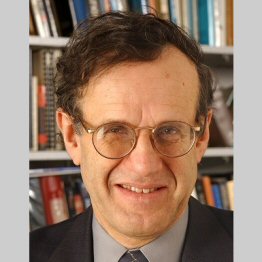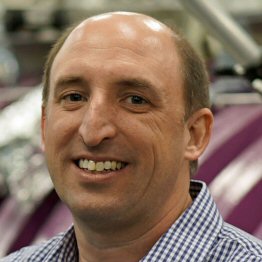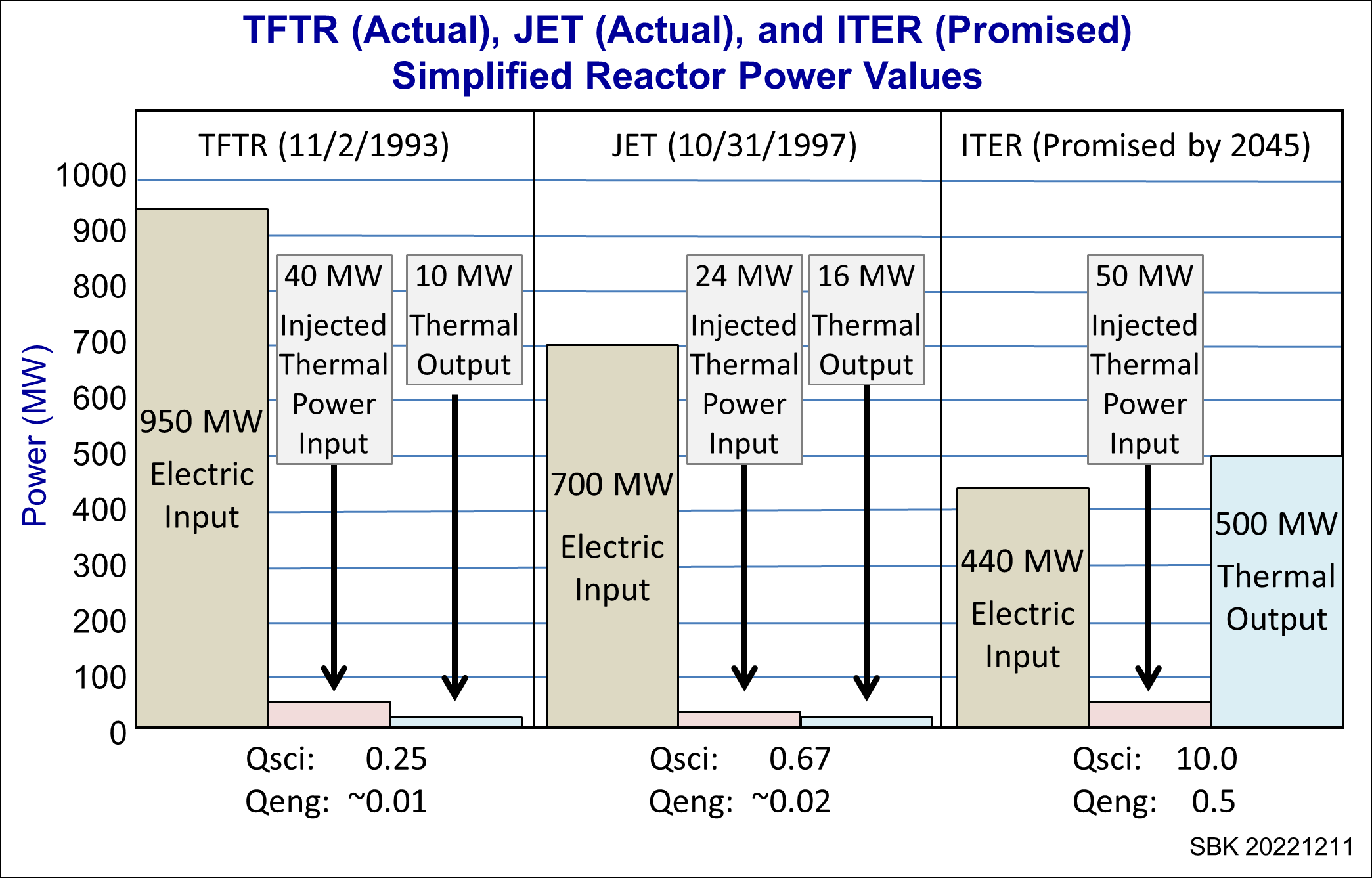#56. The Question Fusion Scientists Don’t Want to Answer
Return to ITER Power Facts Main Page
By Steven B. Krivit
Oct. 31, 2020
In December 2014, I performed a test to see what journalists might learn from a sampling of fusion scientists if journalists wanted to know how close fusion research had come to demonstrating practical levels of power. I sent e-mails to each of the 20 members of the U.S. Department of Energy’s Fusion Energy Sciences Advisory Committee. I asked them one question: “What is the best total net power output from any kind of fusion experiment thus far?” The answers I received were less than helpful.
The answer to my question was the Oct. 31, 1997, experiment at the Joint European Torus, known as JET. For an input of 700 megawatts of electricity, JET produced fusion reactions with 16 megawatts of thermal power. Those paired values, 16 and 700, reflect the reactor power gain, which is an output/input ratio of 0.01. In that experiment, 24 megawatts of thermal power were injected into the plasma to heat the fuel. Those paired values, 16 and 24, reflect the fusion reaction power gain, which is an output/input ratio of 0.67.
To summarize, the reactor power gain for JET was 0.01. The fusion reaction power gain for JET was 0.67.
Members of the public, judging by the vast majority of fusion news stories in the last 50 years, don’t care about fusion reaction power gain. John and Jane Q. Public care only about reactor power gain. That’s what they’ve been promised for their tax dollars: a fusion reactor that produces net energy. They don’t want fusion energy science. They want fusion energy.
The responses I received from members of the Fusion Energy Sciences Advisory Committee, which used to be known as the Fusion Energy Advisory Committee, would surely have misled me had I not stumbled on the 700-megawatt value and the difference between reactor power gain and fusion reaction power gain a month earlier.
The communication gap evident in the responses I received partly explains how so many journalists received information from fusion experts and, in turn, reported the incorrect power values. The other reason journalists reported ITER incorrectly is the result of the misleading language by ITER proponents and the input power values they omitted, as explained in this report.
In one of more than 200 examples that demonstrates the communication failure, Columbia University professor Gerald A. Navratil, an internationally recognized fusion expert, told journalist Patrick J. Kiger that “ITER will allow us to achieve its goal of producing 500 megawatts of fusion power with 50 megawatts of power input into the plasma.”
Fusion scientists did not use distinct terms when discussing “reactor power” or “fusion reaction power.” They used the phrase “fusion power” for both meanings and imagined that non-experts would be able to figure out the right meaning by context. When non-experts didn’t figure it out, fusion experts never corrected them because the incorrect interpretation always resulted in a grossly exaggerated perception of fusion progress.
Thus, Kiger wrote that experimental fusion reactors have “required more energy to operate than the fusion generates. But ITER hopes to overcome that. … ITER will use 50 megawatts of power input to generate 500 megawatts of fusion energy, in the form of heat.” Actually, the ITER design calls for 300 megawatts of input power, not 50.
The failure of fusion scientists to clearly distinguish between reactor power gain and fusion reaction power gain was and still is pervasive. The eight responses I received from members of the committee provide a focused examination of their failure to communicate effectively with journalists.

Christopher J. Keane
Christopher J. Keane, vice president for research and professor of physics at Washington State University, did not try to answer my question. Instead, he wrote that I should direct my question to Stephen Dean, a former U.S. Department of Energy fusion research director, who cofounded a fusion advocacy organization.

Robert Rosner
Robert Rosner, a professor in the departments of Astronomy and Astrophysics and Physics at the University of Chicago, wrote that JET’s net output/input power ratio was “well below 1,” but he didn’t provide further details. From his response, I could not determine whether he was referring to 0.67, JET’s fusion reaction power gain ratio, or 0.01, JET’s reactor power gain ratio.

John E. Foster
John E. Foster, associate professor in the Department of Nuclear Engineering and Radiological Sciences at the University of Michigan in Ann Arbor, directed me to the JET experiment, but he did not state a value for total net power output.

Bruce Cohen
Bruce Cohen, an associate program leader for magnetic fusion theory and computations in the Fusion Energy Program at the Lawrence Livermore National Laboratory, responded but was initially vague.
I wrote back to him: “Does this mean that the best fusion performance so far, of total system output over total system input, was 0.65, at JET?”
“Yes,” he replied.
I knew that was wrong so I wrote to him a third time:
Let me double-check any possible assumptions. As a non-expert in fusion research and the associated terminology, are there any major unstated assumptions that I should be aware of for this number? In other words, is the 0.65 number generally accurate for the measure of total system output power over total system input power?
Here is his response:
The fusion gain factor Q is defined as the amount of fusion power output divided by the total power input to maintain the plasma at steady state. There is a nice discussion of this in Wikipedia (where else?). So Q= fusion power out / power in. Yes is the answer to your question. JET got Q~0.65. This achievement represented steady progress over forty years and many, many orders of magnitude improvement in fusion performance in laboratory experiments.
But I wasn’t asking about a comparison of output power to the “total power input to maintain the plasma at steady state.” I had repeatedly asked about a comparison of output power to “total system input power.”
“Yes,” which he provided twice, was not the honest or accurate answer to my question.

Steve Zinkle
In a similar manner, Steve Zinkle, in the Department of Nuclear Engineering and Department of Materials Science and Engineering at the University of Tennessee, answered my question only in the context of fusion reaction power gain rather than reactor power gain. He made no effort to ensure that I knew he was talking only about the former rather than the latter:
Net power production has not yet been demonstrated in any fusion experiment to date; that is one of the missions of the international ITER device that is under construction in France, where power production on the order of 10 times the power used to heat the plasma is intended to be studied. In the mid- to late-1990s, three international Tokamak devices achieved equivalent ratios of power produced divided by input power (Q) of 0.27 (TFTR in Princeton), 0.65 (JET in Culham, England), and ~1 (JT-60 in Oarai, Japan).
Zinkle made no effort to make sure that I understood that his use of the term “input power” was limited to only the power that is injected into and reaches the plasma rather than input power required and used by the overall experiment or reactor.

Troy Carter
Troy Carter, in the Department of Physics and Astronomy at University of California, Los Angeles, responded to my question in a similar way:
The highest fusion power produced to date in the laboratory was in the JET experiment where 16MW of fusion power was generated (for about 1 second); however, around 22MW of heating power was used to keep the plasma hot enough to allow fusion to occur. This was back in 1997, the last time a magnetic confinement experiment used tritium fuel. JET is due to have another tritium campaign soon (2017) and reaching break-even is a goal. The recent experiments on NIF might have a higher power level (very short duration) but are also not net producers of energy.
Carter answered my question only in the context of fusion reaction power gain rather than reactor power gain and made no effort to ensure that I knew he was talking only about the former rather than the latter.

Gertrude Patello
Gertrude Patello, a senior project manager in the Energy & Environment Directorate at the Pacific Northwest National Laboratory, declined to answer my question but directed me to the chairman of the committee, Mark Koepke.

Mark Koepke
Mark Koepke, professor of physics at West Virginia University, chair of the Department of Energy’s Fusion Energy Sciences Advisory Committee and the immediate past chair of the Plasma Physics Division of the American Physical Society, provided me with the 0.65 value attained at JET. I asked him to confirm that he was telling me JET’s total system output over total system input was 0.65. Here is his full response:
Fusion power output over injected power was 0.65. I am being specific to fusion power when I talk about output, rather than using the phrase total system output, so that I am not including extraneous quantities. I am being specific to injected power when I talk about input, which refers to neutral beams and radio-frequency heating, rather than using the phrase total system input, again so that I am not including extraneous quantities. In some sense, my ratio is more relevant to “scientific” break-even rather than “engineering” break-even or “commercial” break-even. I don’t know what JET’s engineering or commercial ratio values were in 1997.
Finally, Koepke was the first to make an effort to differentiate between reactor power gain and fusion reaction power gain. Nevertheless, Koepke brushed aside the 700 megawatts of electricity needed to operate the reactor as “extraneous.” His ratio was not “more relevant” “in some sense” to scientific rather than engineering breakeven. His ratio was explicitly and exclusively associated with scientific breakeven but he didn’t want to be direct.

Dale Meade
In addition to committee members, I also asked Dale Meade, who had been the leader of the Princeton TFTR experiment. Here’s his first answer:
In 1994, TFTR produced 10.7 MW of fusion power by heating the plasma with 40 MW, for a fusion gain of 0.27. In 1997, JET produced 16 MW of fusion power by heating the plasma with 25 MW, for a fusion gain of 0.64.
I reminded him of my questions: “What is the best net total system power output in Watts? What was the percent of total system power out/total system power in?”
Meade said that, in fusion, “there is a central power core that produces or amplifies input power,” and he repeated his first answer using the phrase “fusion power core.”
I repeated my request for “net total system power output.” He said that total reactor power balance was not one of the crucial remaining unknown issues. All the power requirements to operate a fusion reactor, aside from heating the plasma, Meade said, were “standard technology.” He also said that he didn’t know the net power values for the Princeton reactor (TFTR) or JET:
For magnetic fusion energy, the crucial unknown issues have to do with the fusion power core (the hot plasma fuel), and we spend essentially all our effort on the fusion power core. The so-called balance-of-plant (magnets, pumps, AC power conversion, and plasma heating power supplies) are more standard technology. The numbers I gave you for fusion power produced, fusion power gained for TFTR and JET are the numbers from experiments carried out twenty years ago that I carry in my head (and laptop). However, I do not have the power consumed by the other balance-of-plant systems, and it will not be trivial to get them.
So, again, repeating what I said before in my first set of answers in the format that I prefer – JET has produced 16 MW of fusion power, when the plasma fuel was heated by 25 MW with a fusion core gain (fusion power produced) / (power injected to heat the plasma fuel) of 0.64. So the core did not produce net power; the net core power was -8MW. If you add the power required for the balance-of-plant, the deficit is much larger, but I don’t have the numbers to determine how much larger.
I had obtained the total input power value (which Meade calls balance-of-plant) of 700 megawatts, for JET, in November 2014 from Nick Holloway, the public information officer for the Culham Centre for Fusion Energy. Sometime later, I searched for the total input power used for TFTR. The only place I was able to locate that value, 950 megawatts, was in the Jan. 14, 1980, issue of the Princeton Alumni Weekly.
Earlier this year, I tried to cross-check that number directly with the Princeton Plasma Physics Laboratory. I first contacted Andrew Zwicker, the public information officer for the lab, on May 26, 2020. Zwicker referred me to Meade, who replied to me on June 8:
The information you requested is related to the experiment carried out 25 years ago on Nov. 2, 1994. I spent several hours reviewing my personal records at home and information available online. I have also spent time contacting several PPPL retirees who were directly involved in those experiments to see if they had access or recollections of that information. No luck yet, but I am still trying.
As of the publication of this article, Meade is still trying to find out how much electrical power the biggest and most important fusion reactor in the history of U.S. fusion program consumed. For now, we can use the value given in the Princeton Alumni Weekly. Here’s a chart showing the power values for TFTR, JET, and promised power values for ITER.

Conclusions
Through these and discussions I have had with other scientists, I realized that fusion experts do not ordinarily think about the total amount of electrical power that goes into any given reactor. In general, the net power output of any given fusion reactor doesn’t cross their minds. They don’t think about the electrical power that is used to heat the plasma. Instead, they think only about the thermal power that is injected and used to heat the plasma.
There are good reasons for the general mode of thinking by fusion experts. First, most fusion experts are plasma physicists. This is a discipline almost exclusively associated with scientific research. It’s been that way for 70 years. Fusion experts are generally not nuclear engineers, who work in a field primarily associated with real, working, practical nuclear fission reactors. Second, fusion experts know that no reactor design, including that of ITER, has ever approached the possible range in which a practical output would be a reasonable conversation topic — but none of the fusion scientists I asked wanted to tell me that directly.
These fusion experts were consistently unable or unwilling to respond accurately to the most likely question any journalist might ask. This gap has contributed greatly to the spread of false information about fusion progress for decades.

